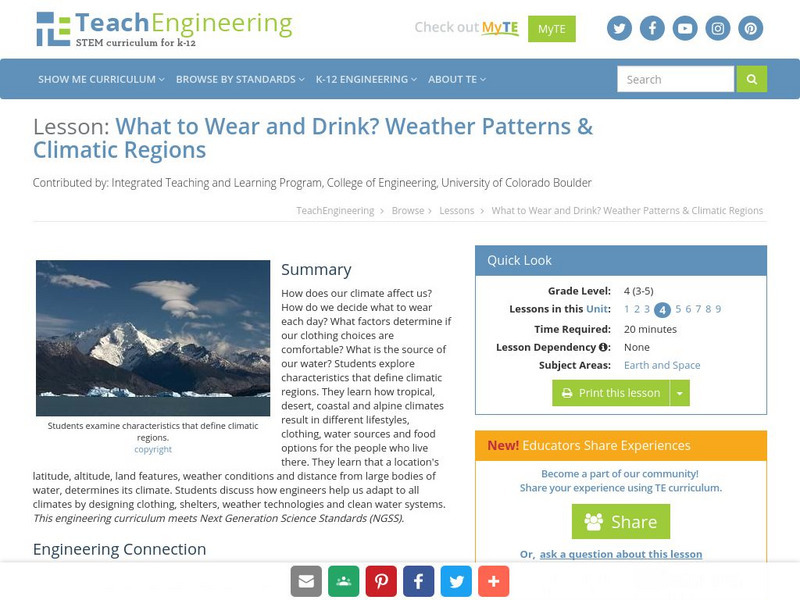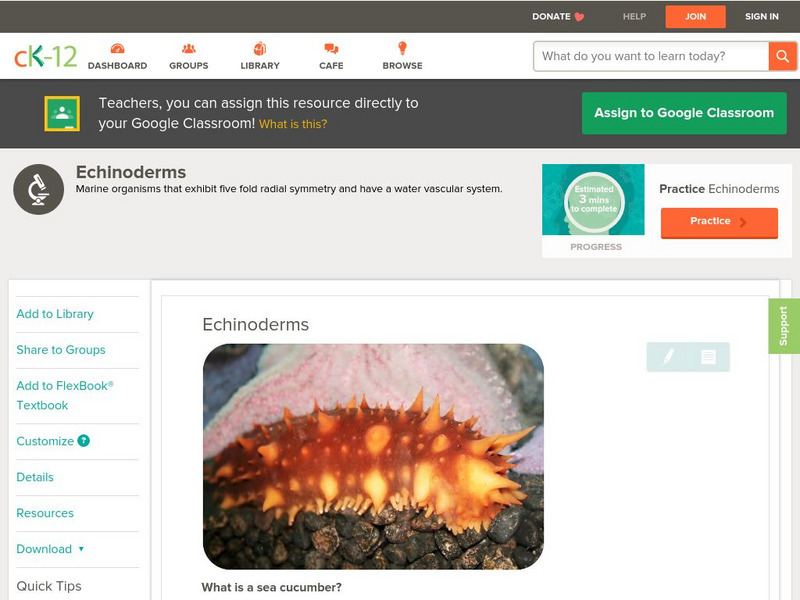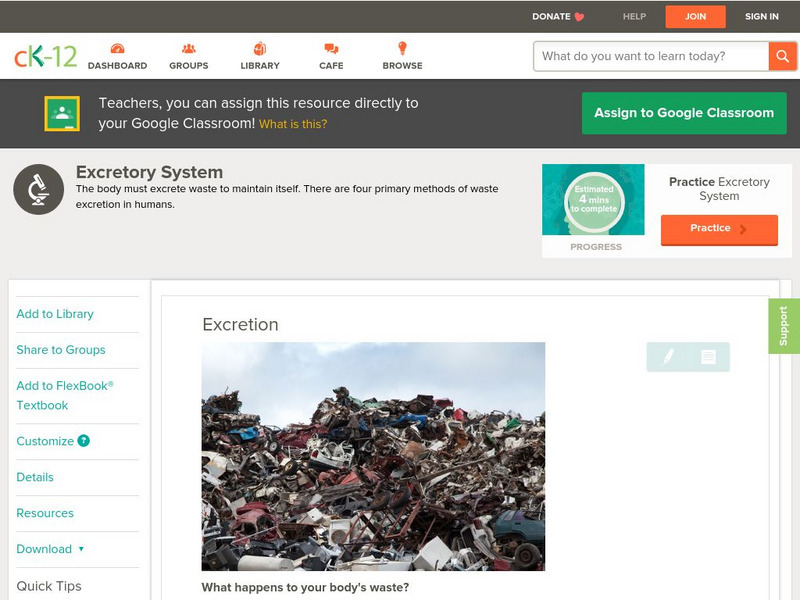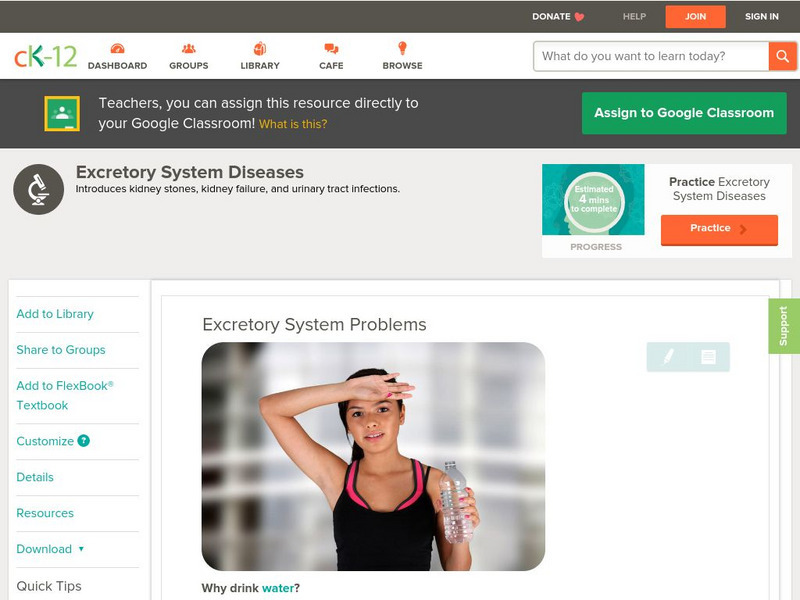Better Lesson
Better Lesson: Making a Landform Model
In the NGSS, one of the performance expectations is for the children to develop a model to represent the shapes and kinds of land and bodies of water in an area. In the science practices, the children also must develop and use models....
Keene College
Geo Granite: Don't Water. . . Shed a Tear
A captivating hands-on lesson where students create a watershed and its tributaries, then learn about the watershed's importance in geographic regions.
BioEd Online
Bio Ed Online: Water
The Science of Water Teacher's Guide provides a number of inquiry-based activities for grades 3-5 (although it can be expanded for other grades). The guide contains science lessons that enable learners to explore water, behavior of...
Other
Bscs: Earth's Changing Surface Lesson 1: Our Land
This hands-on lesson focuses on the land and its many different types of landforms and bodies of water. Included are a minute-by-minute lesson plan, activities, and teacher discussion points and questions.
PBS
Pbs Learning Media: Mapping Landforms and Water Bodies: Lesson Plan
Learn about different landforms and water bodies and the various characteristics that make them distinct from one another in this lesson plan from WGBH. Navigate around a virtual island to unlock information -- including videos and...
Alabama Learning Exchange
Alex: Water You Doing to Help?
In this instructional activity from "The Friends of Auntie Litter", (www.auntielitter.org), bodies of water in the Gulf Coast will be explored. Students will also simulate an oil spill. This instructional activity is one from the "Take...
The Association of the British Pharmaceutical Industry
Abpi: Homeostasis: Kidneys and Water Balance
A complete, self-paced lesson on homeostasis in the human body, focusing on kidney function. Students work their way through illustrated and animated tutorials, and answer review questions along the way. There is a self-checking quiz at...
TED Talks
Ted: Ted Ed: Sylvia Earle's Ted Prize Wish to Protect Our Oceans
What's been happening to the world's oceans over the past 50 years? Ocean researcher, Sylvia Earle, shares breathtaking images of the ocean and surprising details about the many problems plaguing its health. [18:12]
TeachEngineering
Teach Engineering: What to Wear? What to Drink? Weather Patterns and Climatic R
How does our climate affect us? How do we decide what to wear each day? What factors determine if our clothing choices are comfortable? What is the source of our water? Students explore characteristics that define climatic regions. They...
TeachEngineering
Teach Engineering: Fresh or Salty?
Between 70 and 75% of the Earth's surface is covered with water and there exists still more water in the atmosphere and underground in aquifers. In this lesson, learners learn about water bodies on the planet Earth and their various uses...
TED Talks
Ted: Ted Ed: What's So Great About the Great Lakes?
The North American Great Lakes- Huron, Ontario, Michigan, Erie, and Superior- are so big that they border 8 states and contain 23 quadrillion liters of water. They span forest, grassland, and wetland habitats, supporting a region that's...
BioEd Online
Bio Ed Online: Microgravity
In this lesson students will use water balloons to simulate the effects of gravity and microgravity on fluid distribution in the body.
TeachEngineering
Teach Engineering: Digestion Simulation
To reinforce students' understanding of the human digestion process, the functions of several stomach and small intestine fluids are analyzed, and the concept of simulation is introduced through a short, introductory demonstration of how...
TED Talks
Ted: Ted Ed: Deep Ocean Mysteries and Wonders
Marine biologist, David Gallo, shows why oceans are important while taking the viewer on a voyage into the ocean and exploring the incredible beauty of marine life. [8:24]
TED Talks
Ted: Ted Ed: The Most Lightning Struck Place on Earth
Lake Maracaibo is the stormiest place on the planet. Thunderstorms rage above this massive body of water for up to 200 days of the year, with each ear-splitting event lasting for several hours. Graeme Anderson lists the factors that...
TED Talks
Ted: Ted Ed: How Do Your Kidneys Work?
After drinking a few glasses of water on a hot day, you might be struck with a sudden urge. Behind that feeling are two bean-shaped organs that work as fine-tuned internal sensors. This video describes how the incredible kidneys balance...
CK-12 Foundation
Ck 12: Life Science: Echinoderms
[Free Registration/Login may be required to access all resource tools.] You're probably familiar with starfish and sand dollars. They are both echinoderms. Sea urchins and sea cucumbers are also echinoderms. What's similar between these...
TeachEngineering
Teach Engineering: What Do Bread and Beer Have in Common?
Students are presented with information that will allow them to recognize that yeasts are unicellular organisms that are useful to humans. In fact, their usefulness is derived from the contrast between the way yeast cells and human cells...
CK-12 Foundation
Ck 12: Life Science: Excretion
[Free Registration/Login may be required to access all resource tools.] You might have noticed that sometimes your urine is darker than usual. This can happens when your body is low on water and trying to reduce the amount of water lost...
CK-12 Foundation
Ck 12: Life Science: Excretory System Problems
[Free Registration/Login may be required to access all resource tools.] The urinary system controls the amount of water in the body and removes wastes. Any problem with the urinary system can also affect many other body systems. Learn...
TED Talks
Ted: Ted Ed: The Left Brain vs. Right Brain Myth
How did the idea that one side of the brain controls the opposite side of the body come about, and what does it get wrong? Elizabeth Waters looks into this long held misconception.

















